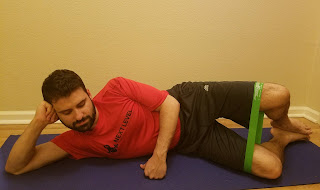Last blog post we talked about the foot and ankle in regards to sports and running injuries. Today, moving up the kinetic chain we'll talk about the importance of a strong and stable hip and core and some of our favorite exercises.
The core and hip muscles play a very important role in controlling movement all the way down to your foot. When these muscles are weak or not firing optimally we will often see the hip and knee "crash in" which can cause a lot of dysfunction and pain. Think about the load through those structures with running which can be 5-12 times your body weight (depending on form and speed). If your mechanics are faulty that is a lot of load being distributed through the wrong places. Note that if you are limited in ankle mobility this can also cause similar movement dysfunction and see our last blog post for how to assess and work on this. Shown below is an example of what happens when weakness/lack of motor control or an ankle mobility restriction is present.
And here is what it looks like when all of the stabilizer muscles fire together and the knee, hip, and ankle stay in good alignment.
That being said, here are some of our favorite exercises for engaging and strengthening those stabilizer muscles to promote a solid foundation for good movement (and help prevent future injury).
Clams: an excellent exercise for activating the deep hip muscles. Shown here using a mini-band for some added resistance. This exercise is great because it isolates each individual side. Place the band above the knees, lie on your side, and with your knees bent bring them up to about a 60 degree angle at your hip. Keeping your feet together, rotate your top knee up. Make sure you don't "cheat" by rolling the top hip back and you should feel a good burn along the outside of your hip. We usually start with 20 reps on each side.
Bridging: here is an exercise that works the bigger glute muscles. We like to use the mini-band around the knees to get a little extra muscle activation. With both knees bent and feet flat on the floor engage your abs by drawing in your belly button and squeeze your glutes as you lift your hips up from the floor. You want to make sure you avoid arching in your low back. Perform 20 repetitions.
Bird/Dog: This exercise has great "bang for your buck" for improving stabilization along many different areas (neck, shoulders, low back, hips) and is a great core control exercise. Begin in a hands and knees position and keeping your abs tight reach "long" not "high" and extend your opposite arm and leg as pictured. Make sure your low back stays neutral (we could balance a glass of water without spilling) and do not allow it to arch. Perform 20 repetitions.
Mule Kicks and Hip Extension on Elbows: next on our list of favorites are some "glute burners" performed in a plank position on elbows. By doing these exercises on your elbows instead of up on your hands you are able to better maintain your low back in a neutral position (avoiding arching). Maintaining that neutral spine helps to also engage your core. In the first picture you lift one leg with the knee bent squeezing your glute for a one second hold at the top. In the second picture you lift with the leg straight (knee extended) and again squeeze those glute muscles for one second on the top. Perform on both sides, 2 sets of 10 reps each.
Forearm Plank: This is an awesome core exercise that is easy to perform anywhere and doesn't stress out the low back like a lot of other popular core exercises. Line yourself up with your elbows under your shoulders, eyes focused on your fists (to maintain a proper neck position), and a neutral spine (again avoiding an arch in the low back). Keep your abdominals tight and squeeze your glutes. The goal is to build up to 3 sets of 30 seconds and then you can begin to add movement to make the exercise more difficult from there.
Side Plank: Last but not least is the often forgotten side plank. If you have a healthy shoulder this is an awesome exercise for working both core and glute muscles together (while also working those shoulder stabilizers). If you are comfortable line your elbow up under your shoulder and push up from the elbow and the feet. If this is too difficult you can modify by bending both knees and pushing through the knees instead. Again the goal is to alternate sides holding for 3 sets of 30 seconds on each.
There you have it! Since these are stability and activation exercises (and not heavily loaded strength training) they are great to perform before your work out or run to get everything firing and optimize your form. Think of it as a quick stability and movement prep routine. Stay strong and injury free out there!
If you like our stuff and want more tips and tricks follow our blog, Facebook, and Instagram accounts @gonextlevelpt










